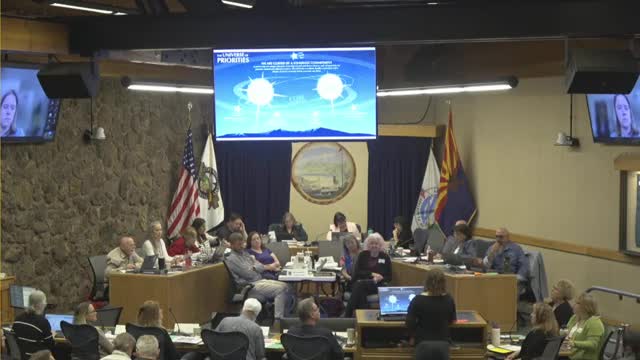Officials debate ‘sense of place’ language; Indigenous voices and native landscaping urged
May 03, 2025 | Flagstaff City, Coconino County, Arizona
This article was created by AI summarizing key points discussed. AI makes mistakes, so for full details and context, please refer to the video of the full meeting. Please report any errors so we can fix them. Report an error »

Planning staff introduced a new “sense of place” section in the reorganized regional plan and proposed several “best practices” — non‑regulatory, technical guidance that would help development respect local character.
Proposed best practices included design elements such as: emphasizing pedestrian‑oriented street frontages, repeating historic patterns where new development abuts historic districts, and using design techniques to break up building mass and bulk.
Public reaction and meeting highlights
Public commentators, indigenous representatives and several elected officials urged the plan to explicitly reflect Flagstaff’s Indigenous history and the region’s ecological character. “We humbly acknowledge the ancestral homelands of this area’s Indigenous nations,” said Council Member Carol House in a longer land‑acknowledgment passage during introductions; Commissioner Rose Tohi and others urged more explicit recognition of cultural connections to the landscape.
Landscaping and visual identity
Several commissioners recommended more explicit guidance promoting native, evergreen (ponderosa‑compatible) landscaping as a cost‑effective and immediate way to reinforce a local visual identity. One commissioner urged a “plant ecologist” role for the city to help ensure plant palettes reflect the region’s pine‑and‑high‑desert character and age into a coherent sense of place.
Design standards vs. plan language
Staff and zoning code managers reminded the group that the regional plan is not a design code and cannot in itself prescribe architectural details. Tiffany (zoning code manager) and other staff said some design review tools (for multifamily and larger projects) are available administratively but full citywide design standards would require code action and careful legal review, especially in light of recent state legislation that affects land‑use rules.
Accessibility and equity
Advocates asked for disability access and inclusion to be explicit priorities in any sense‑of‑place language. Housing advocates and several officials said sense of place must also be tied to affordability and access so that the character of Flagstaff does not become accessible only to higher‑income households.
Ending: Staff will refine the sense‑of‑place language and the best‑practices list, and will flag where topics require code changes (design standards) versus where non‑regulatory advisory language is appropriate.
Proposed best practices included design elements such as: emphasizing pedestrian‑oriented street frontages, repeating historic patterns where new development abuts historic districts, and using design techniques to break up building mass and bulk.
Public reaction and meeting highlights
Public commentators, indigenous representatives and several elected officials urged the plan to explicitly reflect Flagstaff’s Indigenous history and the region’s ecological character. “We humbly acknowledge the ancestral homelands of this area’s Indigenous nations,” said Council Member Carol House in a longer land‑acknowledgment passage during introductions; Commissioner Rose Tohi and others urged more explicit recognition of cultural connections to the landscape.
Landscaping and visual identity
Several commissioners recommended more explicit guidance promoting native, evergreen (ponderosa‑compatible) landscaping as a cost‑effective and immediate way to reinforce a local visual identity. One commissioner urged a “plant ecologist” role for the city to help ensure plant palettes reflect the region’s pine‑and‑high‑desert character and age into a coherent sense of place.
Design standards vs. plan language
Staff and zoning code managers reminded the group that the regional plan is not a design code and cannot in itself prescribe architectural details. Tiffany (zoning code manager) and other staff said some design review tools (for multifamily and larger projects) are available administratively but full citywide design standards would require code action and careful legal review, especially in light of recent state legislation that affects land‑use rules.
Accessibility and equity
Advocates asked for disability access and inclusion to be explicit priorities in any sense‑of‑place language. Housing advocates and several officials said sense of place must also be tied to affordability and access so that the character of Flagstaff does not become accessible only to higher‑income households.
Ending: Staff will refine the sense‑of‑place language and the best‑practices list, and will flag where topics require code changes (design standards) versus where non‑regulatory advisory language is appropriate.
View full meeting
This article is based on a recent meeting—watch the full video and explore the complete transcript for deeper insights into the discussion.
View full meeting
